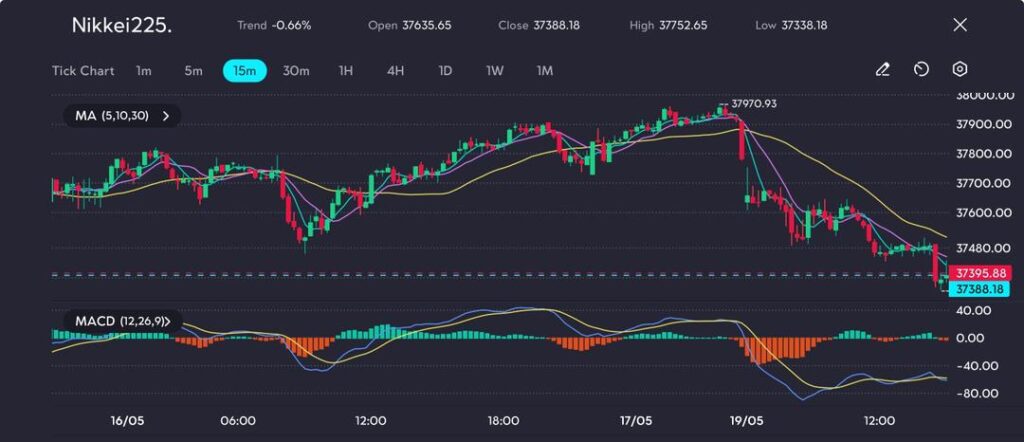
Key Points:
- Nikkei225 closes 0.68% lower at 37,498.63 after Moody’s cuts U.S. credit rating.
- Stronger yen dents exporter sentiment; chip stocks lead losses.
Japan’s benchmark Nikkei225 fell sharply on Monday, shedding 0.68% to settle at 37,498.63, as a stronger yen and concerns over the U.S. fiscal outlook pressured sentiment. The broader Topix index managed to stay mostly flat, closing just 0.08% lower at 2,738.39.
The selloff was triggered by Moody’s decision to downgrade the U.S. sovereign credit rating late Friday, citing America’s ballooning $36 trillion national debt. The downgrade rekindled fears of a broader exodus from U.S. assets, leading to safe-haven inflows into the yen, which firmed 0.4% to 145.05 per dollar during Asian trading hours.
A stronger yen tends to weigh on Japanese exporters, as it reduces the value of overseas earnings once repatriated. Reflecting this concern, chip-related stocks came under pressure, with Advantest (6857) and Tokyo Electron (8035) falling 2.85% and 1.7%, respectively.
Moody’s move is likely to complicate Trump’s ambitions for renewed tax cuts, raising concerns about further fiscal instability that could disrupt global capital flows.
Still, the day wasn’t without gainers. Daiichi Sankyo (4568) surged 7%, leading the Nikkei’s advance and offering some relief amid the broader sell-off. Roughly 50% of Tokyo-listed stocks closed higher, 45% declined, and 3% ended unchanged—indicating a mixed but cautious mood.
Technical Analysis
The Nikkei 225 faced a sharp correction after hitting a high of 37,970.93, pulling back steadily over the past sessions to close at 37,388.18. The index has broken below both the 10- and 30-period moving averages on the 15-minute chart, confirming bearish momentum. The recent drop was accompanied by a negative MACD crossover and widening histogram bars, signalling downside continuation pressure.

Picture: Nikkei retreats from 37,970 peak, slides toward 37,300 with bearish momentum firmly in control, as seen on the VT Markets app
Despite an earlier rebound attempt around midday on 17 May, bullish momentum was short-lived. Price action has since formed lower highs and lower lows, pointing to a weakening trend. Support now lies around the 37,300 level, with further downside risk if this is breached. Resistance is found near the 37,750–37,800 region. If the MACD continues to flatten, we may see a short-term consolidation, though the bias remains bearish unless bulls reclaim higher ground above the 30-period MA.
Cautious Forecast
While Japanese equities are still supported by firm corporate earnings and expectations of continued domestic monetary support, external shocks such as U.S. fiscal instability and renewed trade friction could weigh heavily in the near term. If the yen continues to appreciate, export-driven sectors could face further downside pressure. Traders will closely watch U.S. Treasury developments and Japanese trade data this week for further direction.









